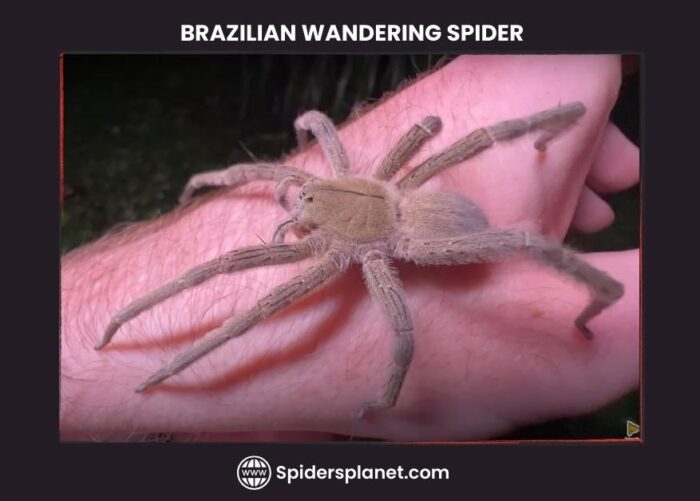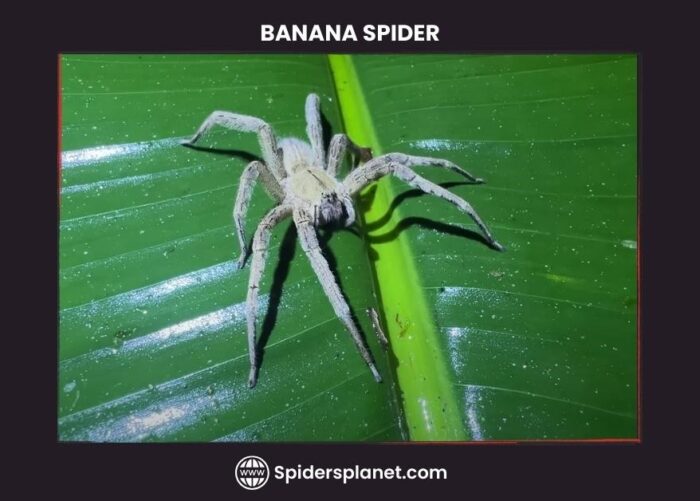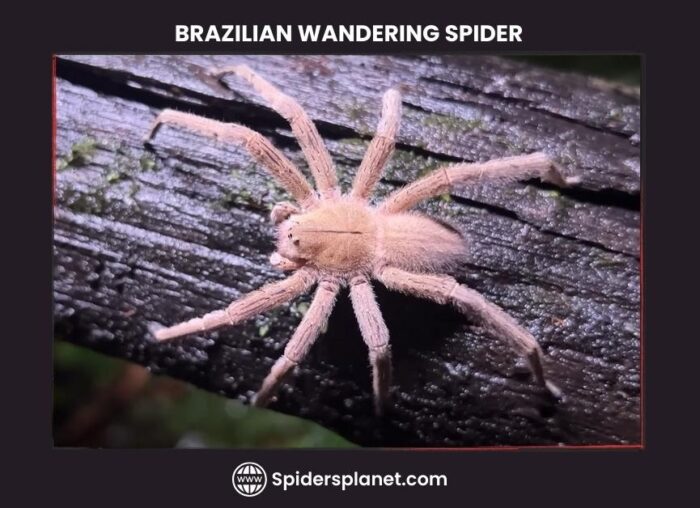Have you ever heard of or do you know what a Brazilian wandering spider is? It is a big venomous spider from places like Central and South America, and people sometimes call it the banana spider. Why? Well, we are about to find out!
These wandering spiders are aggressive hunters who go out on the hunt at night. Their meals include both invertebrates (like insects) and vertebrates (creatures with a backbone, like small animals).
These spiders are super dangerous because their venom is like a powerful potion that can make people really sick or even worse. They usually hang out in tropical rainforests and even in cities, hiding in banana plants.
So, let’s get more information about the world of this sneaky spider to learn the details about its looks, eating habits, where it lives, the venom it carries, and find out if it is genuinely risky. Ready to explore? Keep reading!
Brazilian Wandering Spider Description:
Scientific Name and Family:
In Brazil, they are sometimes known as “armed spiders” (armadeiras), and they share the name “banana spiders” with a few other spiders. They have different names, but they are all talking about the same interesting spider!

The Brazilian wandering spider, scientifically known as Phoneutria, Maximilian Perty kickstarted the Phoneutria genus in 1833. The name comes from the Greek word φονεύτρια, which means “murderess” and falls under the Animalia kingdom, Arthropoda phylum, and Arachnida class.
Within Arachnida, it is classified in the order Araneae, infraorder Araneomorphae, and Ctenidae family. The genus Phoneutria, described by Perty in 1833, includes the type species Phoneutria fera.
This classification helps us understand where these spiders fit into the larger picture of living organisms.
Species:
The following 9 species are accepted by The World Spider Catalog:
- Phoneutria bahiensis
- Phoneutria boliviensis
- Phoneutria eickstedtae
- Phoneutria fera
- Phoneutria keyserlingi
- Phoneutria nigriventer
- Phoneutria pertyi
- Phoneutria reidyi
- Phoneutria depilata
What do Brazilian Wandering Spider look like?
Size Range:
The spiders in the Phoneutria group can get pretty big in size. Their legs can stretch out to be 13 to 18 centimeters (5 to 7 inches) wide, and their bodies can have a range between 17 to 48 millimeters (a little more than half an inch to almost 2 inches) long.
The female Brazilian spiders can get pretty big, reaching up to 15 centimeters (5.9 inches) in length. On the other hand, the males are smaller, usually measuring around 7 centimeters (2.8 inches). They usually weigh up to 0.21 ounces.
They have long, slender legs, and even though some other spiders with different names might have longer legs, the Phoneutria spiders are champions when it comes to having the longest bodies and being the heaviest in their spider gang.
Anatomy:
The spider’s body has two main parts. The first is the prosoma, kind of like its “head,” where you will find all eight legs, eyes, fangs (chelicera), and little multitasking arms (pedipalps).
The second part is the opisthosoma, holding the spinnerets for making silk, the back end opening (anal opening), “the lungs,” the heart, and the important bits for making baby spiders (reproductive organs).
So, the prosoma is like the front control center, and the opisthosoma is like the back office, handling things like silk-making and baby-making.
Color:
Brazilian spiders come in different colors, with most being hairy and shades of brown and gray. Some species may have lightly colored spots on their abdomen.
A distinctive feature of many species is the presence of bands of black and yellow or white on the underside of their two front legs.
Identification:
To identify a spider from the Phoneutria group, look for a dense brush of fine hairs on their leg parts. They might seem like other spiders, especially Cupiennius, but here is how you can differentiate:
- Phoneutria often have a dark line on the front of their palps and a thin black line on top of their head.
- Check underneath, too; their legs usually have dark parts and light joints. Sometimes, the belly has black dots or is reddish.
- Usually it has been observed that when they are upset, they do a cool defensive move like lifting their front legs high with a distinctive pattern. So, if you see a spider doing that dance, it is probably a Phoneutria!
Habitat:
Brazilian Wandering Spiders live all over the Americas, from Costa Rica to northern Argentina. They are like the residents of the jungle, chilling in forests east of the Andes in countries like Colombia, Venezuela, Ecuador, Peru, Bolivia, Brazil, Paraguay, and the Guianas.
Some, like P. reidyi, P. boliviensis, and P. fera, love the Amazon rainforest, while others prefer the Atlantic Forest in Argentina, Paraguay, and Brazil.
They have also made themselves at home in the Cerrado savanna. But if you head to northeastern Brazil, they are not around. These spiders have even taken trips to Chile and Uruguay.
Why are they called Banana Spiders?
These spiders are linked with bananas. Richard S. Vetter, a researcher at the University of California, found that these powerful spiders sometimes end up in North America and Europe by accident, hitching a ride in banana shipments.

But it is often a case of mistaken identity. Only a few Phoneutria species have been found in banana shipments, and sometimes, other spiders get the blame due to misidentification.
What They Like to Eat or Hunt?
Their food includes flies, beetles, butterflies, moths, grasshoppers, locusts, and crickets. Occasionally, they might even feast on small creatures like amphibians, reptiles, or mice. All these diet or food findings tell us about how diversified eating habits these fascinating spiders have.
Mating and Lifecycle:
Like most spiders, the female spiders are bigger than the males. When the male spider wants to be friends, they do a little dance (vibrating his pedipalps and specialized sensory appendages) to signal his intentions to impress the female, but it is a cautious approach.
The behavior of the female can be choosy, and she might say no to a few before picking the right one.
After the dance, sometimes, the females decide to attack them, or if she is interested, she can store the male’s baby-making material in a special place until she is ready to use it.
Then, she lays a bunch of eggs, up to 1,000 at a time, and keeps them safe in a silk egg sac. Sadly, after laying her eggs, the mom spider says goodbye. It is her way of making sure the new spiders are ready to explore the world on their own.
The lifespan of the banana spider (Phoneutria nigriventer) differs for males and females. Females usually live for 6 to 8 weeks after reaching maturity, while males have a shorter lifespan of 2 to 3 weeks after their last molt.
Predators:
Certain mammals, like coatis (Procyonidae, which includes raccoons) and other small insectivores, birds are potential predators of large wandering spiders.
Behavior:
These spiders got their name as wandering spiders because of the fact that they are not into web building. Instead, they stroll around the forest floor at night(nocturnal), searching for dinner.
Brazilian Wandering Spiders are active hunters and use both ambush tactics and direct attacks to catch their prey. During the day, they prefer cozy spots like under logs or in crevices, only emerging at night for their hunting adventures. These spiders do not build nests like other spider species.
While wandering spiders are not naturally aggressive towards humans, they won’t hesitate to bite if they feel cornered or threatened. Most bites happen when a spider accidentally gets trapped in clothing or bedding.
Bite and Venom:
The bite of the armed spider is the most dangerous in the world as the venom it carries can be harmful to humans.
The danger is not just about how strong the venom is; it is also about factors like the spider’s likelihood to bite and how close it is to where people live.
These spiders often hide in houses, clothes, and other dark places during the day, making accidental bites more likely.
While their fangs are adapted for small prey, some experts think they might give a “dry” bite in defense to save venom. Studies suggest that not all bites inject venom, and serious cases requiring antivenom are rare.
However, there have been confirmed cases of death, with symptoms appearing quickly, including:
- Severe pain
- Breathing difficulties
- Increased heart rate and blood pressure
- In severe cases, paralysis and death
The severity can depend on the spider’s sex, with females generally more dangerous. The spiders produce less venom in colder months, and a small amount can be potent enough to harm.
Fortunately, bites from Brazilian spiders are rare, and when they do occur, the exposure to the toxins is generally mild, as explained by Vetter.
Also Read: What is a Huntsman Spider? (Heteropodidae) – The Ultimate Guide
Banana Spider’s Facts:
Below are essential details about Brazilian wandering spiders:
- They hold the title for the world’s largest spiders, boasting leg spans reaching up to 15 centimeters (6 inches).
- Their venom packs a powerful punch, capable of inducing severe pain, paralysis, and, in extreme cases, fatal outcomes for humans.
- Despite their intimidating reputation, they are generally non-aggressive and resort to biting only when provoked.
- These spiders inhabit tropical rainforests and urban areas across Central and South America.
- In case someone has been bitten by this spider, he/she needs quick medical treatment to control the effects timely.

Treatment and Preventive Measures:
If bitten by a wandering spider or armed spiders, prompt medical attention is crucial. There is an antivenom for the spider’s venom, but its effectiveness is highest when administered within a few hours of the bite.
To prevent a bite:
- Wear protective clothing, use shoes and long pants when in areas where these spiders are found.
- Before wearing your clothes and shoes, make sure to check them to ensure no spiders are hiding.
- Maintain cleanliness and avoid leaving food or garbage exposed, as this can attract spiders.
These preventive measures are essential for minimizing the risk of encountering and getting bitten by Banana spiders.
FAQs:
Can Brazilian spiders kill humans?
Brazilian wandering spiders (Phoneutria nigriventer) are venomous and can potentially kill a human with a single bite. Their venom contains a potent neurotoxin that can cause severe pain, paralysis, and even death.
Are Brazilian spiders poisonous?
Yes the venom of this spider is poisonous, that can cause death. While Brazilian wandering spiders are potentially dangerous, actual bites are relatively rare.
By adopting preventive measures and promptly seeking medical attention if bitten, the risk of serious complications can be significantly reduced.
Can you keep Brazilian spiders as pets?
It is strongly advised against keeping wandering spiders as pets due to their venomous nature and the potential risk to human safety.
Managing these spiders in captivity demands specialized knowledge and handling procedures to minimize the risk of bites.
Final Thoughts:
The Brazilian wandering spider, banana spider, or armed spider is a large and venomous arachnid found in Central and South America. While their potent venom can be harmful to humans, encounters are rare.
These nocturnal hunters have adopted various habitats, from rainforests to urban areas, and are associated with banana shipments. Understanding their appearance, behavior, and habitat is crucial for minimizing risks.
Seeking immediate medical attention after a bite is essential, as antivenom is available but most effective when administered promptly. Despite their fearsome reputation, the Brazilian spider remains a captivating and potentially dangerous species.




Leave a Reply